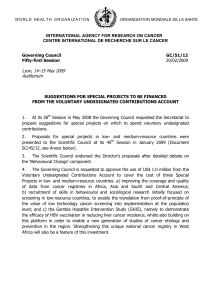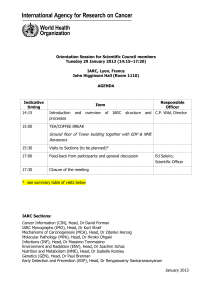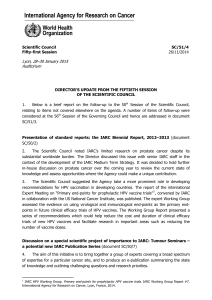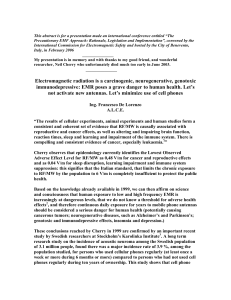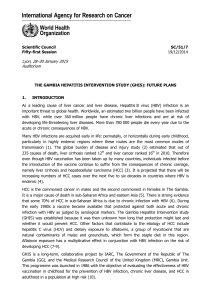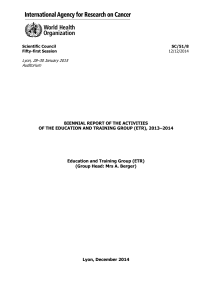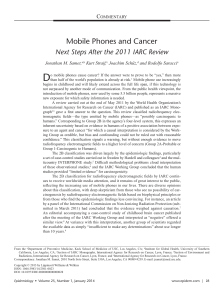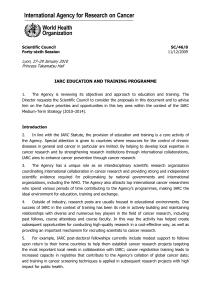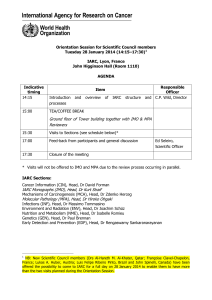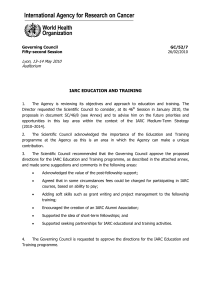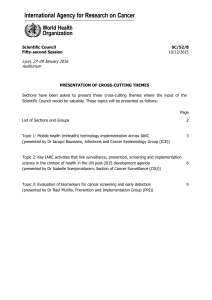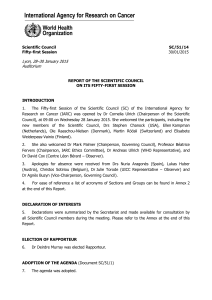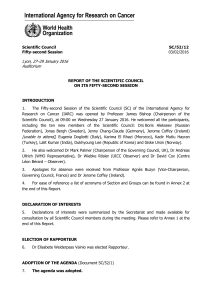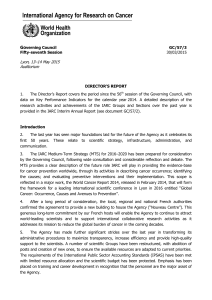Lyon, 27–29 January 2016 Auditorium
publicité
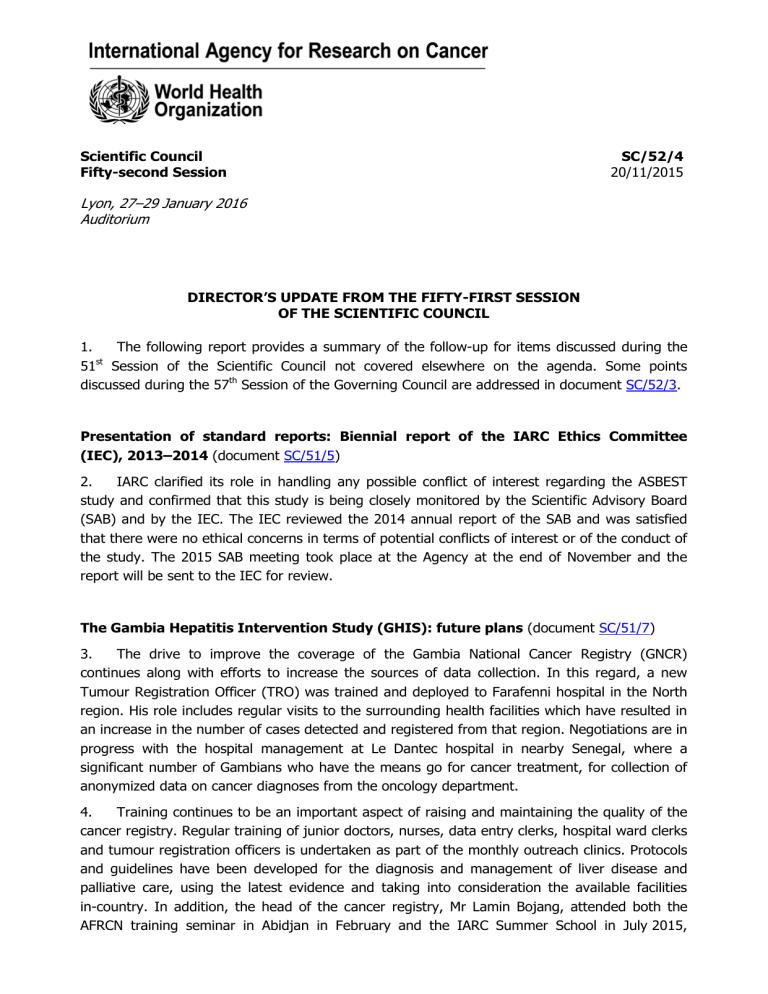
Scientific Council Fifty-second Session SC/52/4 20/11/2015 Lyon, 27–29 January 2016 Auditorium DIRECTOR’S UPDATE FROM THE FIFTY-FIRST SESSION OF THE SCIENTIFIC COUNCIL 1. The following report provides a summary of the follow-up for items discussed during the st 51 Session of the Scientific Council not covered elsewhere on the agenda. Some points discussed during the 57th Session of the Governing Council are addressed in document SC/52/3. Presentation of standard reports: Biennial report of the IARC Ethics Committee (IEC), 2013–2014 (document SC/51/5) 2. IARC clarified its role in handling any possible conflict of interest regarding the ASBEST study and confirmed that this study is being closely monitored by the Scientific Advisory Board (SAB) and by the IEC. The IEC reviewed the 2014 annual report of the SAB and was satisfied that there were no ethical concerns in terms of potential conflicts of interest or of the conduct of the study. The 2015 SAB meeting took place at the Agency at the end of November and the report will be sent to the IEC for review. The Gambia Hepatitis Intervention Study (GHIS): future plans (document SC/51/7) 3. The drive to improve the coverage of the Gambia National Cancer Registry (GNCR) continues along with efforts to increase the sources of data collection. In this regard, a new Tumour Registration Officer (TRO) was trained and deployed to Farafenni hospital in the North region. His role includes regular visits to the surrounding health facilities which have resulted in an increase in the number of cases detected and registered from that region. Negotiations are in progress with the hospital management at Le Dantec hospital in nearby Senegal, where a significant number of Gambians who have the means go for cancer treatment, for collection of anonymized data on cancer diagnoses from the oncology department. 4. Training continues to be an important aspect of raising and maintaining the quality of the cancer registry. Regular training of junior doctors, nurses, data entry clerks, hospital ward clerks and tumour registration officers is undertaken as part of the monthly outreach clinics. Protocols and guidelines have been developed for the diagnosis and management of liver disease and palliative care, using the latest evidence and taking into consideration the available facilities in-country. In addition, the head of the cancer registry, Mr Lamin Bojang, attended both the AFRCN training seminar in Abidjan in February and the IARC Summer School in July 2015, Scientific Council Director’s update from the 51th Scientific Council SC/52/4 Page 2 where he received training in cancer registration and data handling using CANREG-5, as well as in cancer epidemiology and survival analysis. A nationwide training workshop is planned for 2016 to coincide with the “Stop Cervical Cancer” conference being organized by the Gambia Government in conjunction with the Princess Nikky Breast Cancer Foundation. 5. To cope with the increasing number of liver patients, to capture all referrals and to assist in the management of in-patients, a second clinician working alongside Dr Ramou Njie has been seconded to the liver clinic. 6. To improve diagnostic accuracy, as from May 2015 Dr Behnoush Abedi-Ardekani, pathologist at IARC, reviews all liver histology sections. A system of transfer of paraffin blocks of biopsy tissue to IARC has been put in place. Dr Abedi-Ardekani will be travelling to The Gambia in December 2015 for a week to provide training for local histopathology technicians. 7. The Prevention of Liver Fibrosis and Cancer in Africa (PROLIFICA) study is in its fourth year of a planned five-year follow-up of patients on treatment with oral Tenofovir for chronic hepatitis B virus (HBV) infection. The Gambian Minister of Health attended the World Hepatitis Summit in Glasgow in September 2015 where he discussed with the head of the WHO Global Hepatitis Programme the possibility of The Gambia being a demonstration country for the HBV elimination agenda. He reiterated the government’s commitment to scaling up treatment for HBV to cover the whole country. 8. A draft proposal and budget for PROLIFICA-II have been prepared and are in discussion. The project proposes to use a study design similar to the GHIS (a stepped-wedge design of cluster randomization) to screen the whole country for chronic HBV carriers over a period of five years. This clearly has a potential impact on the completion of the GHIS, hence statistical and epidemiological advice will be sought from Professors Hazel Inskip and Andrew Hall, who were responsible for GHIS implementation, prior to embarking on the scaling up of treatment. Biennial report of the activities of the Education and Training Group (ETR), 2013–2014 (document SC/51/8) 9. The Scientific Council requested that the frequency with which the e-learning resources are utilized be calculated. This monitoring has been set up. Relevant data will be included as part of the Biennial Reports provided by ETR to the Scientific Council. 10. Regarding funding of the Fellowship Programme, after two consecutive successful applications for EC-FP7 Marie Curie Actions-People-COFUND grants, in 2010 and 2013 respectively, ETR submitted a new application under the H2020-MSCA-COFUND-2015 call, for a total amount of €1 179 000. The application is currently under review. In addition, and as announced at the Governing Council in May 2015, the Agency has been negotiating an agreement with the Research Council of Norway, for the training of postdoctoral scientists from Norway at IARC.



